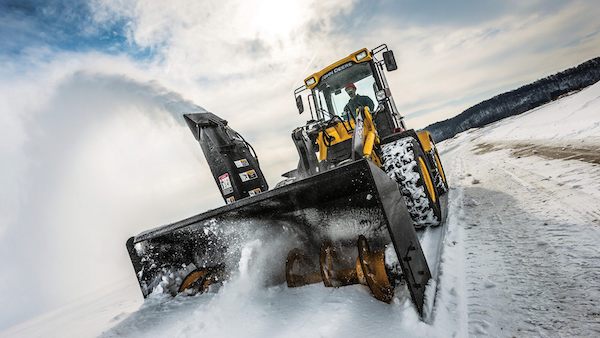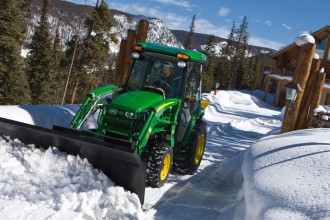The winter season can be hard on your machines, their engines, and their batteries. When you need your snow equipment, there is usually heavy snow and sleet, meaning it is necessary for your equipment to start the second you need it. Similarly, you don’t want to start off spring with equipment that doesn’t start. Let’s take a look at winter equipment, how to winterize your machines, and how to maintain parts of these machines so you can keep them running and starting all year long.
This guide will walk you through the essential steps to winterize your tractor from choosing the right attachments to maintaining your engine, fuel, and battery for cold-weather performance.
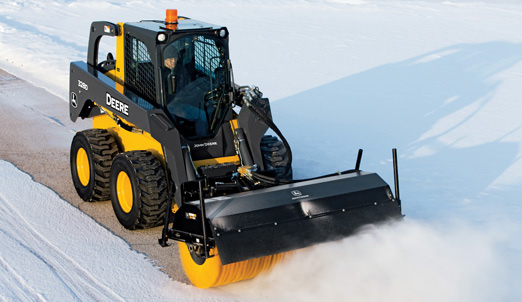
Key Takeaways
- Equip your machine for snow with attachments like snow blades, pushers, brooms, and blowers tailored for different snow conditions.
- Use winter-grade fuel and conditioners to prevent freezing and fuel gelling in low temperatures.
- Inspect and maintain wear parts like rubber hoses, tires, belts, and fluids to avoid cold-weather breakdowns.
- Protect and store your batteries by fully charging them, disconnecting the ground cable, and keeping them in a cool, dry place.
- Warm up engines properly and use tools like block heaters, glow plugs, and diesel additives to ensure reliable winter starts.
Winter Attachments for Winterizing Your Tractor
Cold air begins coming in quickly as we enter the winter months, meaning it’s never long before the ground is blanketed in snow. Fortunately, snow pushers, snow blades, and more can make your winter easier. In addition, there are many valuable pieces of equipment that can help you get through winter with ease. Choosing the right snow and ice attachments is a key part of winterizing your tractor, ensuring it can operate safely and efficiently in harsh weather:
- Broom Attachments
- Bucket Attachments
- Snow Blades
- Snowblowers
- Snow Pushers
Broom Attachments
Broom attachments are perfect for shoveling a light dusting of snow. They are typically used when a snowplow or blower would be too heavy-duty for the job. These brooms attach easily to all machines and come with a deflector, which helps to keep the snow from blowing everywhere.
Bucket Attachments
Bucket attachments allow you to plow driveways and sidewalks with ease. The strength of these buckets makes them ideal for a variety of purposes, but not just for snow removal. Knowing you can get a job done perfectly without putting any additional physical strain on yourself makes this attachment crucial for your lawn tractor.
Snow Blades
Snow blade attachments look similar to a truck plow and are perfect for clearing away moderate amounts of snowfall. With snow blades angled 30 degrees to the left and right, you can easily relocate snow into small areas such as driveways, sidewalks, and more.
Snow Pushers
When sidewalks are frozen or caked with sand and salt, it might not be the ideal situation to use a snowblower. Snow pushers are an alternative to snowblowers, which are capable of pushing even larger accumulations of snow off of messy sidewalks, parking lots, driveways, and more.
Snowblowers
This snowblower is not just an average snowblower. It can cut through heavy snow, as well as ice, while blowing it as far as 45 feet away. Similarly to the broom, snowblowers come with a deflector in order to make sure snow is not being thrown into your face or anywhere else it may not belong.
Winter Equipment Maintenance for John Deere Tractors
The cold weather doesn’t mean you need to stop using your lawn equipment. Here are some tips for winterizing your machine so you can get the most out of it this season.
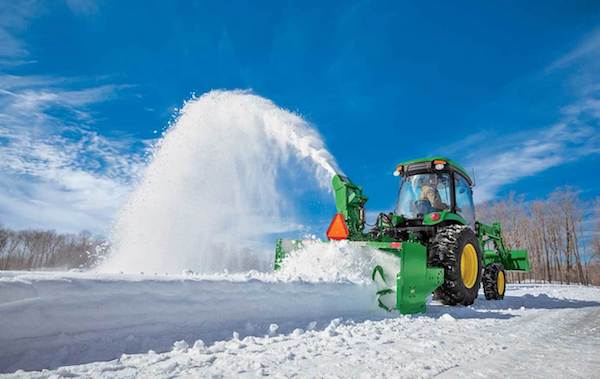
The Best Fuel to Use in Cold Weather
First off, it is crucial you are using winter-grade fuel – this is because this fuel is made specifically for temperatures below 32 degrees Fahrenheit. This will ensure that in cold weather operations, your fuel will not freeze, meaning you don’t have to be worried about your machine not working.
You will also want to begin treating any biodiesel fuels with Fuel Conditioner when temperatures drop below 41 degrees Fahrenheit. When temperatures fall below 32 degrees Fahrenheit, you will want to use B5 or lower blends. At temperature below 14 degrees Fahrenheit, using only winter-grade petroleum diesel fuel is a necessity.
Winter Tire Pressure & Rubber Wear Checklist
Inspecting your rubber equipment is another checklist item that you will want to make sure you take a look at. Since rubber becomes harder and even more brittle under cold temperatures, it is more likely to crack and break apart in the colder weather. You will want to look at any rubber tires, tracks, hoses, and belts to ensure they are not cracking and rotting before every operation.
Your tire pressure is another priority as well. When the temperature drops, your tire pressure may change, meaning you will want to make sure they are filled adequately before your next operation.
Winter Fluid Check: Oil, Coolant, and Water Separation
You will need to maintain your other fluids. You can determine these amounts by referring to your operator’s manual for the necessary diesel engine oil and engine coolant requirements.
Similarly, you will always want to check for water and residue buildup. This may be more of a problem when condensation builds up during the winter months. Water will likely settle at the bottom, so allow any fluids to sit for several hours or even overnight. To check for water, drain a small amount of the fluids from tanks, reservoirs, and oil pans.
Lastly, you will need to load-test your batteries to make sure they are ready to perform before you start your engine.
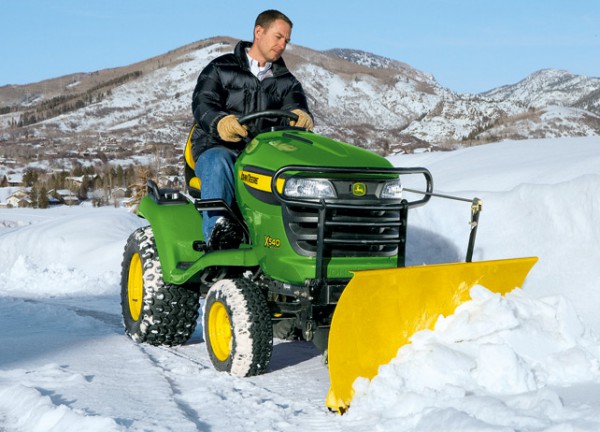
How to Prep Your John Deere Lawn Tractor for Winter Use
Some areas are currently preparing for cold and harsh winter weather. Winter can be a long, cold season and to make the most out of your equipment throughout these months, there are attachments you may need to winterize your vehicle. Although preparing for winter takes a certain amount of time and effort, it is well worth it when your machinery operates smoothly in any type of weather with the right equipment:
- Floor Mats
- Deluxe Cab Glass Door Kit
- Cab Heater
- HD Skid Plate Extension Panel
- Seat Cover
- Vehicle Cover
- Markers
Floor Mats
Unfortunately, when the snow starts melting, thick muds are likely to get tracked into vehicles. Getting floor mats allows you to keep your equipment clean since they are washable. Additionally, they help to protect your floor, thereby minimizing any debris or mess at the operator station.
Deluxe Cab Glass Door Kit
Gators can also be equipped with glass door kits, which help you protect yourself and your vehicle from all and any elements. This kit also contains a complete automotive seal, which is for the cab frame. It keeps all bad weather outside, including dreaded snow flurries.
Cab Heater
While many glass components of a Gator are tinted to absorb heat, freezing conditions can oftentimes leave the cab a bit cold. Cab heater kits help to increase the temperature inside of the cab so you can feel comfortable year-round. This heater has two-speeds and a high-output, so it can do wonders when frost takes over your windshield.
HD Skid Plate Extension Panel
In the winter, impaired vision can be a huge problem because of flurrying snow, hail, and more. Similar to this, debris can also be found all-over. Deflector plates help you to fill the gaps between front and rear skid plates. This helps to protect power components from said debris, such as rocks, sticks, and leaves.
Seat Cover
There are many winter days where the temperature is above 32 degrees, which results in melted snow. This water can then begin to pool, causing many problems for your machine. Seat covers help you to avoid this since they have a centralized drain hole for any water, allowing you to stay warm and dry.
Vehicle Cover
Once work is finished on a long, winter day, it is time to shut your vehicle’s engine down. This cover for your vehicle is made of a heavy-weighted fabric, which protects your entire vehicle from tough conditions, no matter what the weather is.
Markers
When there is heavy snow, your blades can be swallowed up. To counteract this, markers help to provide operators with visual aids, so blade edges can be viewed during the plowing process.
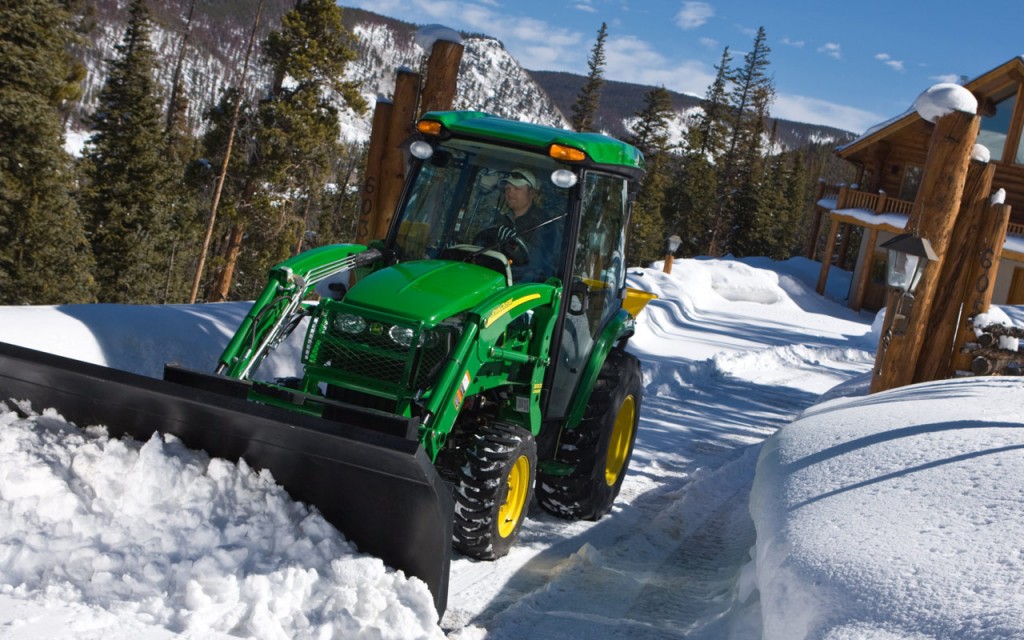
Battery Care & Storage for Winter Months
Those who live in colder climates have most likely run into issues where their car or another piece of machinery has had a battery fail to start. A battery replacement, in the middle of the winter, is no simple walk in the park. Thankfully, there are preventative measures you can take to prevent a battery from failing in the cold weather.
Fully Charge Your Batteries
Batteries need to be fully charged before being placed into storage. A low-charge battery is more prone to freezing, which can cause permanent internal damage. Fully charging your battery not only protects it during cold snaps, but also ensures your machine is ready to start when winter ends — without the need for replacement or jump-starting.
How To Store Your Batteries for Winter
Batteries will discharge over time, but lower temperatures actually slow the process. If you will not be using your equipment, it is a good idea to consider storing it in a cool location — ideally between 32°F and 50°F. Avoid placing the battery directly on concrete floors, which can accelerate discharge. Use a shelf or insulated surface instead.
Disconnect Negative Ground Cable
Operators must disconnect the negative ground cable. This also helps reduce discharge caused by electrical components that slowly draw current even when the machine is off. By removing the ground cable, you help the battery maintain its charge longer. Remember, you will also want to restore this cable before the end of the season to avoid issues when restarting the engine.
Cold‑Start Tips & Engine Care in Winter
For those planning to work throughout the winter months, it’s essential to learn how to start and manage engines, including diesel, in cold weather or otherwise. Doing so is crucial to keeping your engine working for seasons to come. For many, unfortunately, this can be extremely hard.
Warm Up Your Diesel Engines
Cold weather requires you to take your time with your engine to allow it to warm up properly. Before operating your machine, you should always leave your equipment to warm up for at least five minutes. This allows the hydraulic oil to warm up, and also helps to reduce wear and tear on your equipment in colder environments. Failing to follow this step will make the engine work harder than is necessary.
Best Ways to Preheat a Diesel Engine in Cold Weather
There are many external sources of heat that you can use to start your engine during the winter. You will want to consider these options if you are willing to invest in another piece of equipment to warm your engine.
- Electric Block Heaters: These heaters warm up the coolant in-stream. This in turn warms the engine and the oil in the crankcase – facilitating the turnover of the engine.
- Glow Plugs: These glow plugs help you ignite cold fuel, and can heat the fuel-air mixtures inside of the large-sized engine.
- Diesel-Fired Coolant Heaters: This type of heater can also allow you to heat up your engine in the area where electricity might not be readily available.
- Battery Tenders: The cranking amperage of machinery batteries diminishes under cooler temperatures. While most types of machinery is prone to this kind of breakdown, battery tenders will remain effective as long as they are at full charge. Before winter, owners of machines should monitor battery cables. Bad connections can reduce a battery’s ability to start your machine.
Keep Diesel Exhaust Fluid in a Warm Place
If you intend to add diesel exhaust fluid to your machinery, make sure it is kept at a temperature above 12 degrees Fahrenheit to prevent it from freezing. Freezing doesn’t impact the uptime of your equipment, however, having the diesel exhaust fluid prepared ensures it’s ready to be dispensed when needed.
Use Winter Diesel to Prevent Fuel Gelling
Utilizing the right fuel ensures you are not using fuel that will gel together in cold weather. Prior to the freezing temperatures, you will want to make it a point to upgrade to winter-grade diesel fuel. Winter-grade fuel is designed with additives to prevent gelling during chilly weather.
Another common barrier to the smooth starting of machinery is diesel fuel forming wax crystals. This fuel can clog your fuel filters and the engine will not run. You can deter crystals from forming in the fuel by using winter-blended fuel.
Keep Engine in a Warm Area
If possible, you will want to store your diesel engine in a warmer area so it will not be exposed to any elements, such as sleet and snow. Keeping an engine in a warmer area can allow it to warm up quicker.
Keep Fuel Tank Full
Condensation in your fuel tank will eventually freeze, causing just as many problems as gelled fuel. You will want to keep your fuel tank full in order to eliminate any space for condensation build-up. Winter diesel fuel additives can also reduce the risk of your fuel freezing as well.
Best Engine Oil for Cold Weather Starts
Lighter oil makes it easier on certain engines as they are started in cold weather. Before cold temperatures move in, you will want to conduct an oil change in order to prep your engine. New oil can also protect your powertrain over time.
Winter Electrical Prep for Diesel Equipment
Greasing your machine before the winter ensures your engine has the best possible chance at starting easily when temperatures drop. You will want to examine the electrical system of your machine and fully charge your system before the weather turns, as damage may occur if you allow the battery to go dead and freeze.
Prepare for Winter with John Deere
Don’t allow the cold weather to keep you from using your John Deere equipment this winter. We hope these steps will help you to start your tractor – even on the coldest of days.
If you have any questions about winterizing John Deere equipment, you can contact your local John Deere dealer.
If you enjoyed this post or want to read others, feel free to connect with us on Facebook, Pinterest, or Twitter!

Winterize a Tractor FAQs
Why is winterizing my John Deere equipment important?
Winterizing protects your engine, battery, fuel system, and rubber components from cold-weather damage. It also ensures your machine starts and runs reliably during winter.
What attachments are best for snow and ice removal?
Popular winter attachments include snow blades, snow pushers, brooms, buckets, and snowblowers. Each serves different snow conditions, from light dustings to heavy, icy accumulation.
What kind of fuel should I use in cold weather?
Use winter-grade diesel fuel below 32°F to prevent freezing and gelling. Treat biodiesel blends with fuel conditioner below 41°F, and switch to B5 or lower blends below 32°F.
How can I prevent fuel gelling in winter?
Use winter-grade diesel and cold-weather fuel additives. Keeping the fuel tank full also reduces condensation, which can freeze and cause engine issues.
How should I care for my battery during winter?
Fully charge the battery before storage, disconnect the negative ground cable, and store it in a cool, dry location. This helps prevent discharge and keeps the battery ready for spring.
What maintenance should I perform on tires and rubber parts?
Cold temperatures make rubber brittle. Inspect tires, hoses, belts, and tracks for cracking before each use, and check tire pressure frequently as it drops in cold weather.
How long should I warm up my diesel engine in winter?
Allow your machine to warm up for at least five minutes before operating. This helps hydraulic oil reach proper temperature and reduces strain on engine components.
What tools can help my engine start in extremely cold weather?
Block heaters, glow plugs, diesel-fired coolant heaters, and battery tenders all improve cold starts and protect your engine when temperatures fall below freezing.

